
“On My Own” is a poignant ballad from Les Misérables, sung by Éponine, expressing her unrequited love and heartbreak. It is a fan favorite, showcasing emotional depth and resilience, making it a pivotal moment in the musical.
1.1 Overview of the Song
“On My Own” is a captivating ballad from Les Misérables, sung by Éponine, expressing her unrequited love for Marius. The song conveys deep emotion, resilience, and longing, making it a fan favorite. Its piano and vocal arrangements are widely available in sheet music formats, including solo and SSA versions. The melody’s simplicity contrasts with its emotional depth, allowing performers to showcase their vocal range and interpretive skills. The song’s enduring popularity stems from its relatable themes of love and heartbreak.
1.2 Historical Context of Les Misérables
Les Misérables, based on Victor Hugo’s 1862 novel, explores themes of redemption, justice, and inequality in 19th-century France. The musical, adapted in 1980, captures the struggles of its characters, resonating universally. Its historical backdrop highlights societal issues, making it a timeless classic. The story’s depth and emotional complexity have cemented its place as one of the most celebrated musicals, adapting into various forms while remaining true to Hugo’s vision of humanity and hope amidst adversity.
1.3 Significance of “On My Own” in the Musical
“On My Own” is a pivotal moment in Les Misérables, highlighting Éponine’s unrequited love for Marius. The song captures her emotional turmoil, self-sacrifice, and resilience. It serves as a contrast to the broader revolutionary themes, offering a deeply personal narrative. The melody’s haunting beauty and poetic lyrics convey the complexity of Éponine’s character, making it a fan favorite and a testament to the musical’s ability to blend individual struggles with grand societal themes, enriching the overall storytelling and emotional impact of the production.
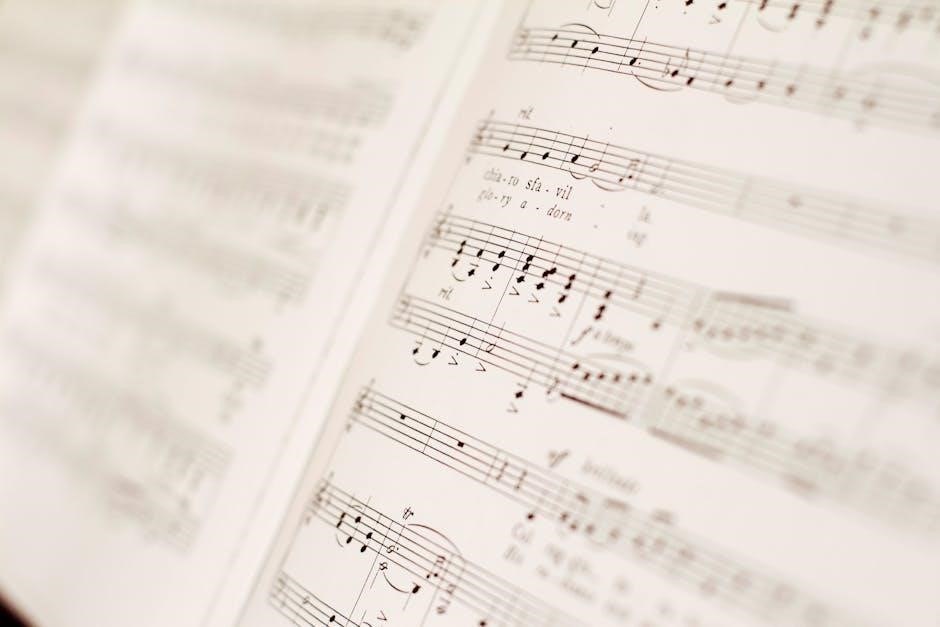
Creators and Composers Behind the Music
Claude-Michel Schönberg composed the iconic music, while Alain Boublil and Herbert Kretzmer crafted the poignant lyrics, with contributions from Jean-Marc Natel, blending drama and emotion into the score.
2.1 Claude-Michel Schönberg and Alain Boublil
Claude-Michel Schönberg and Alain Boublil are the masterminds behind the music of Les Misérables. Schönberg, a renowned composer, crafted the powerful melodies, while Boublil, a talented lyricist, wrote the original French lyrics. Their collaboration brought depth and emotion to the musical, with “On My Own” being one of their most celebrated creations. Together, they ensured the music resonated globally, blending drama and passion into every note. Their work remains iconic, defining the legacy of the musical.
2.2 Herbert Kretzmer’s Role in the Lyrics
Herbert Kretzmer played a vital role in adapting the French lyrics of Les Misérables into English. Collaborating with Alain Boublil and Jean-Marc Natel, Kretzmer ensured the emotional depth of “On My Own” was preserved in translation. His lyrical work captured Éponine’s heartbreak and longing, making the song relatable to global audiences. Kretzmer’s contribution was instrumental in the musical’s international success, blending poetic sensibility with dramatic intensity.
2.3 Jean-Marc Natel’s Contribution
Jean-Marc Natel collaborated with Claude-Michel Schönberg and Alain Boublil on the original French version of Les Misérables. He contributed to the lyrical foundation of “On My Own,” which was later adapted into English. Natel’s work laid the emotional groundwork for Éponine’s poignant ballad, ensuring the song’s themes of unrequited love and resilience resonated deeply. His collaboration was pivotal in shaping the musical’s narrative and its enduring legacy, making him a key figure in its creative development.
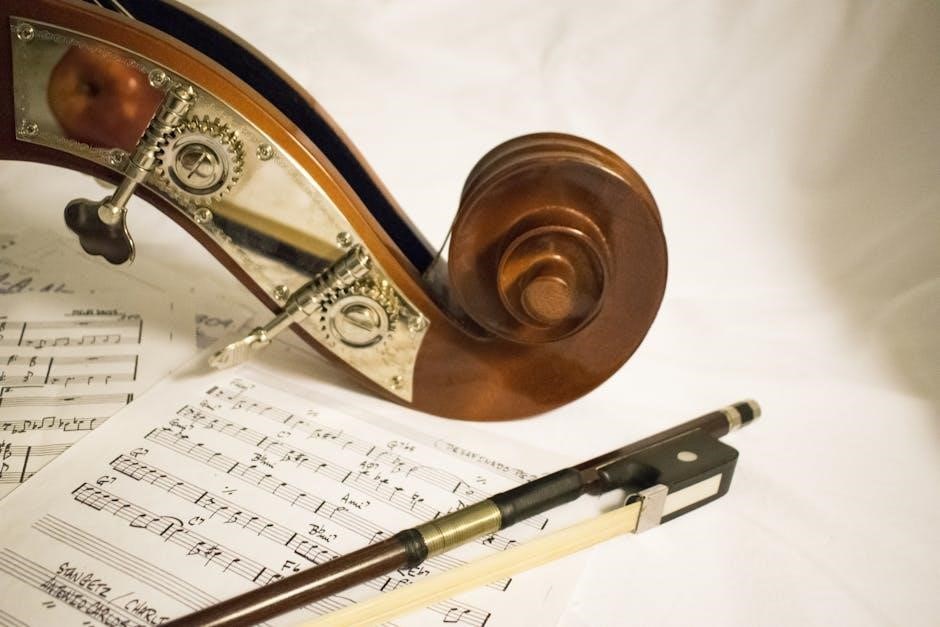
Sheet Music and Piano Arrangements
The sheet music for “On My Own” is widely available as PDF downloads, including piano and SSA arrangements, making it accessible for various performers and a popular choice for pianists and choirs alike.
3.1 Availability of “On My Own” Sheet Music
The sheet music for “On My Own” is widely available in various formats, including PDF downloads. It can be found on platforms like Scribd, Docero, and other musical repositories. Both free and paid versions are accessible, catering to different needs. The arrangements range from solo piano to SSA (Soprano, Soprano, Alto) with piano accompaniment, making it suitable for individual performers and choirs. This accessibility has contributed to the song’s popularity among musicians and enthusiasts worldwide, ensuring its enduring presence in musical repertoire.
3.2 Piano Cover and Solo Arrangements
Piano covers of “On My Own” are widely popular, offering a simplified yet emotionally rich interpretation of the song. Solo arrangements are available in various formats, including PDF downloads, catering to pianists of all skill levels. These arrangements often preserve the song’s poignant melody while adapting it for solo performance. Many versions maintain the original’s emotional depth, allowing pianists to convey the longing and resilience embedded in Éponine’s iconic ballad. This adaptability makes the piano cover a beloved choice for both personal enjoyment and public performance.
3.3 SSA and Piano Arrangements
The SSA (Soprano, Soprano, Alto) and piano arrangement of “On My Own” is a popular choice for vocal ensembles. This version, lasting approximately 2:55, features lyrics by Alain Boublil, Herbert Kretzmer, and others, with music by Claude-Michel Schönberg. The arrangement beautifully captures the emotional nuances of Éponine’s journey, blending harmonies with a piano accompaniment that mirrors the original orchestration. It is widely available as a PDF download, making it accessible for choirs and vocal groups seeking to perform this powerful piece from Les Misérables.
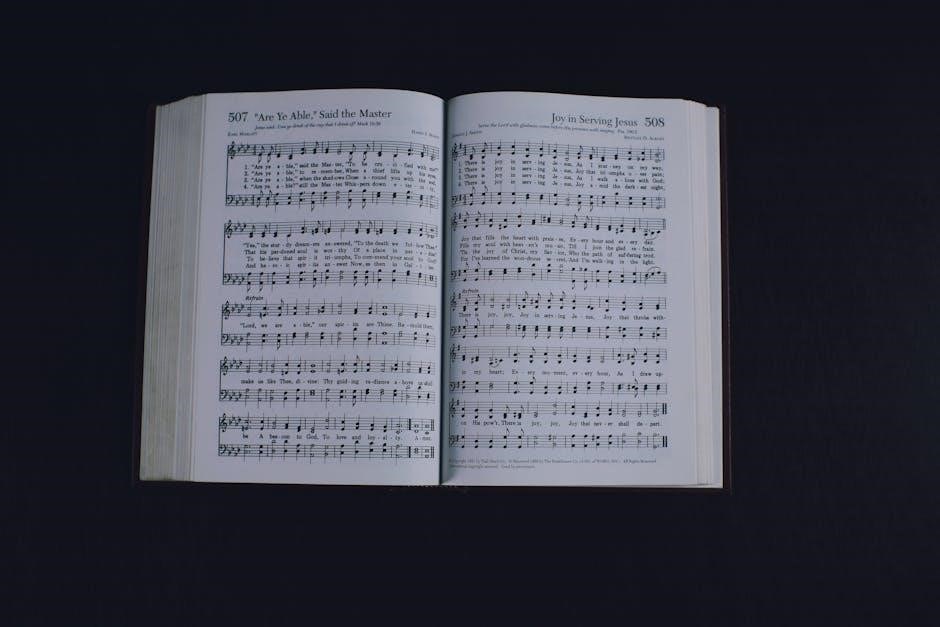
Lyrics and Their Meaning
The lyrics of “On My Own” express Éponine’s heartbreak and longing, capturing her unrequited love for Marius. Poetic imagery and emotional depth resonate deeply, making the song timeless.
4.1 Poetic Depth of the Lyrics
The lyrics of “On My Own” are rich in poetic imagery, capturing Éponine’s emotional journey. Metaphors like “in the shadow of the night” evoke longing and solitude. The song’s verse structure builds tension, while the chorus resolves it, creating a sense of catharsis. Themes of unrequited love and self-sacrifice are woven with elegant simplicity, making the song a timeless reflection of human emotion. The poetic depth resonates universally, connecting listeners to Éponine’s heartfelt story.
4.2 Emotional Expression in the Song
“On My Own” beautifully captures Éponine’s emotional turmoil, blending vulnerability with resilience. The lyrics convey her longing for Marius and acceptance of her unrequited love. The song’s melody, with its soaring highs and melancholic lows, mirrors her inner conflict. The emotional depth is heightened by the contrast between hope and despair, creating a powerful connection with listeners. Éponine’s journey from heartbreak to selfless love resonates universally, making the song a emotional highlight of Les Misérables.
4.3 Copyright and Legal Aspects
The music and lyrics of “On My Own” are copyrighted by Editions Musicales Alain Boublil, with English lyrics by Herbert Kretzmer. Proper licensing is required for performances or adaptations. Unauthorized use of the sheet music or recordings may infringe on these rights. Legal downloads from trusted sources ensure compliance with copyright laws, supporting the creators and preserving the integrity of the work. Always verify the source to avoid legal issues and respect the intellectual property of the composers and lyricists.
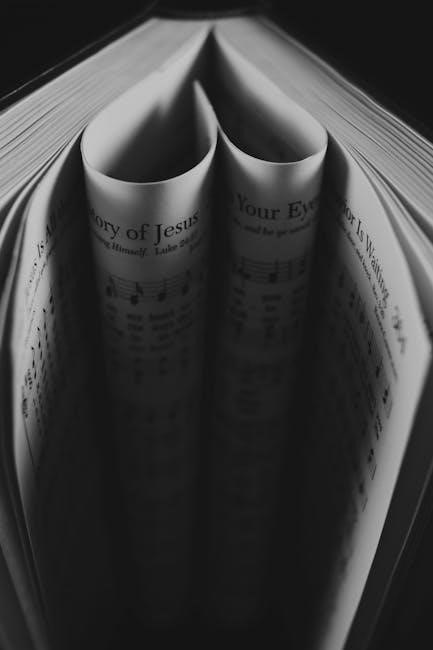
Musical Analysis
“On My Own” features a haunting melody, rich harmonies, and dynamic variations. The song’s emotional depth is enhanced by its expressive tempo and heartfelt musical phrasing, resonating deeply with listeners.
5.1 Melodic Structure

The melody of “On My Own” is characterized by a soaring and emotive structure, with a mix of stepwise motion and leaps that convey the emotional turbulence of Éponine’s unrequited love. The song begins with a simple, haunting motif that builds into a powerful crescendo, reflecting the intensity of her feelings. The use of minor keys and expressive intervals adds to the poignant and reflective nature of the melody, making it a standout piece in the musical.
5.2 Harmonic Progressions
The harmonic progressions in “On My Own” are a masterclass in emotional storytelling. The song primarily uses minor keys to evoke melancholy, with strategic modulations that heighten tension. The i-vi-IV-V progression, common in ballads, is enriched with suspended chords and unexpected shifts, adding complexity. These progressions build tension, reflecting Éponine’s emotional struggle, and resolve softly, underscoring her resignation. Dynamics and orchestration enhance the harmonic texture, making the song a standout.
5.3 Tempo and Dynamics
The tempo of “On My Own” is moderate, with a steady pace that allows for emotional expression. Dynamics vary from soft, introspective moments to powerful crescendos, emphasizing Éponine’s emotional journey. The sheet music indicates subtle shifts in volume, with pianissimo sections for vulnerability and forte peaks for dramatic intensity. These dynamic contrasts, paired with tempo variations, create a compelling narrative, drawing listeners into Éponine’s heartfelt struggle and resignation.

Cultural Impact and Legacy
“On My Own” has become an iconic anthem, resonating emotionally with audiences worldwide. Its poignant melody and relatable lyrics have inspired countless covers and adaptations, solidifying its legacy as a timeless musical masterpiece.
6.1 Popularity of “On My Own” Globally
“On My Own” has gained immense global popularity, resonating with audiences due to its emotional depth and universal themes of unrequited love. The song’s availability as a free PDF download and its adaptations for piano, solo, and SSA arrangements have made it accessible to musicians worldwide. Its inclusion in various musical performances and covers further highlights its enduring appeal, making it a beloved piece across cultures and languages, solidifying its place as a timeless musical treasure.
6.2 The Song’s Role in the Musical’s Success
“On My Own” plays a crucial role in the success of Les Misérables, as it emotionally resonates with audiences, deepening the story of Éponine’s unrequited love. Its poignant lyrics and soaring melody make it a standout piece, enhancing the musical’s dramatic impact. The song’s availability as a free PDF and its adaptations for various performances have further amplified its reach, contributing to the musical’s enduring popularity and critical acclaim worldwide.
6.3 Covers and Interpretations
“On My Own” has inspired numerous covers and interpretations, showcasing its timeless appeal. Artists and performers worldwide have reimagined the song, from solo piano arrangements to SSA choir versions. Its emotional depth and universality make it a favorite for adaptations, further cementing its legacy. These interpretations highlight the song’s versatility and enduring popularity, allowing new generations to connect with its powerful message and melody.

Performance and Interpretation
“On My Own” captivates audiences with its emotional core, delivered through powerful vocal and piano arrangements. Famous renditions, like Liz Callaway’s, highlight its dramatic intensity, while tips for performers emphasize connecting deeply with Éponine’s vulnerability and passion.
7.1 Famous Performances of “On My Own”
“On My Own” has been memorably performed by talents like Liz Callaway, whose powerful rendition captures Éponine’s heartbreak. Frances Ruffelle, the original Éponine, delivered a hauntingly emotional performance. These iconic interpretations have etched the song into musical theater history, showcasing its universal appeal and emotional depth, inspiring countless covers and adaptations while remaining a cornerstone of Les Misérables performances worldwide.
7.2 Tips for Performing the Song
Performing “On My Own” requires emotional depth and vocal precision. Vocalists should connect with Éponine’s longing and heartbreak, conveying vulnerability through nuanced phrasing. Pianists should emphasize dynamic contrasts, following the sheet music’s cues for dramatic impact. Breathing techniques are crucial to sustain the song’s powerful crescendos. Practice with a metronome to maintain tempo consistency, especially during the crescendo. Emphasize diction for clarity, ensuring lyrics resonate emotionally. Rehearse with the piano accompaniment to master timing and dynamics, delivering a polished and moving performance.
7.3 Vocal Range and Technique
“On My Own” demands a moderate to advanced vocal range, spanning A3 to E5. The song requires precise control, especially in upper registers, to convey Éponine’s emotional depth. Breath support is crucial for sustained phrases and crescendos. Dynamics play a key role, transitioning from soft, vulnerable moments to powerful climaxes. Proper diction and phrasing are essential to deliver the lyrics’ poetic intensity. Practice with a metronome to maintain tempo accuracy, and focus on legato singing for a seamless performance. Emphasize emotional connection to truly capture the song’s essence.
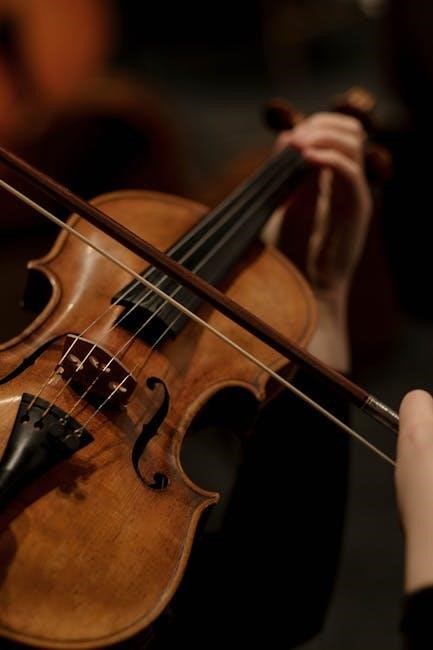
Download and Resources
“On My Own” sheet music is widely available as PDF downloads for piano and vocal arrangements. Trusted sources include Musicnotes and SheetMusicPlus, offering both free and paid versions. Ensure compliance with copyright laws when downloading or using the sheet music for performances or educational purposes.
8;1 Free PDF Downloads
Free PDF downloads of “On My Own” sheet music are available online, offering piano, vocal, and SSA arrangements. Websites like Musicnotes and SheetMusicPlus provide access, though some may require purchase. Ensure downloads are from trusted sources to maintain quality and legality. Many versions include lyrics and piano accompaniments, ideal for personal use or performance. Always verify licensing terms to comply with copyright laws, even for free downloads. These resources are perfect for musicians and educators seeking affordable access to this beloved musical piece.
8.2 Trusted Sources for Sheet Music
Trusted sources for “On My Own” sheet music include official platforms like Musicnotes, SheetMusicPlus, and MuseScore. These websites offer high-quality, legally licensed arrangements for piano, vocal, and SSA formats. Additionally, educational institutions and libraries often provide access to sheet music through subscriptions. Always prioritize official publishers or well-known music distributors to ensure authenticity and compliance with copyright laws. These sources guarantee accurate transcriptions and support the creators of the music.
8.3 Legal Considerations for Usage
Using “On My Own” sheet music requires adherence to copyright laws. The song is copyrighted by Claude-Michel Schönberg and Alain Boublil, with English lyrics by Herbert Kretzmer. Any public performance, commercial use, or distribution must obtain proper licensing. Unauthorized reproduction or sharing of sheet music can lead to legal consequences. Ensure all usage complies with intellectual property rights by purchasing from trusted sources like Musicnotes or SheetMusicPlus. Always verify the legality of free downloads to avoid infringement;
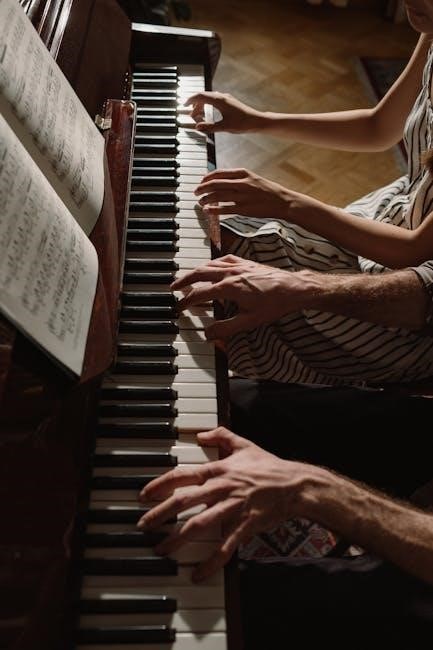
Educational Use
“On My Own” is widely used in music education, with its sheet music and lyrics employed to teach vocal techniques, emotional expression, and musical theater history, engaging students deeply.
9.1 Using “On My Own” in Music Classes
The sheet music for “On My Own” is a valuable resource in music education, offering insights into musical theater and vocal performance. Teachers often use the song to teach emotional expression, diction, and phrasing. The availability of SSA and piano arrangements makes it accessible for choral groups. Students can analyze the lyrics for poetic depth and practice interpreting complex emotions. Additionally, the song’s historical context within Les Misérables provides opportunities to explore the broader themes of the musical. It is particularly effective for developing vocal technique and storytelling skills, making it a popular choice for music classrooms and workshops.
9.2 Analyzing the Song for Educational Purposes
“On My Own” offers rich material for educational analysis, particularly in understanding musical theater. The song’s structure, lyrical themes, and emotional depth provide insights into storytelling through music. Educators can explore its melodic and harmonic elements, such as the piano accompaniment, to teach musical phrasing and dynamics. The lyrics, with their poetic imagery, can be studied for language and emotional expression. Additionally, the historical context of Les Misérables adds layers of cultural and literary significance, making it a valuable tool for interdisciplinary learning and critical thinking exercises in music and drama classes.
9.3 Incorporating the Song into Curriculum
Incorporating “On My Own” into the curriculum enhances music, drama, and language arts education. Educators can use the song to teach musical theater history, lyrical analysis, and emotional expression. The sheet music and piano arrangements provide practical tools for music classes, while the lyrics offer opportunities for poetic interpretation. The song’s historical context, tied to Victor Hugo’s novel, can be integrated into literature or history lessons. Additionally, its emotional depth makes it ideal for exploring themes of resilience and unrequited love, fostering critical thinking and empathy in students of all levels. This multifaceted approach enriches interdisciplinary learning experiences.




